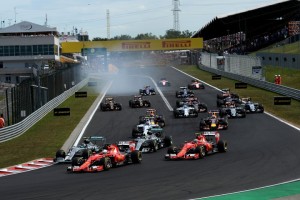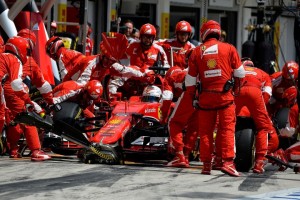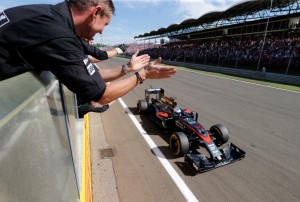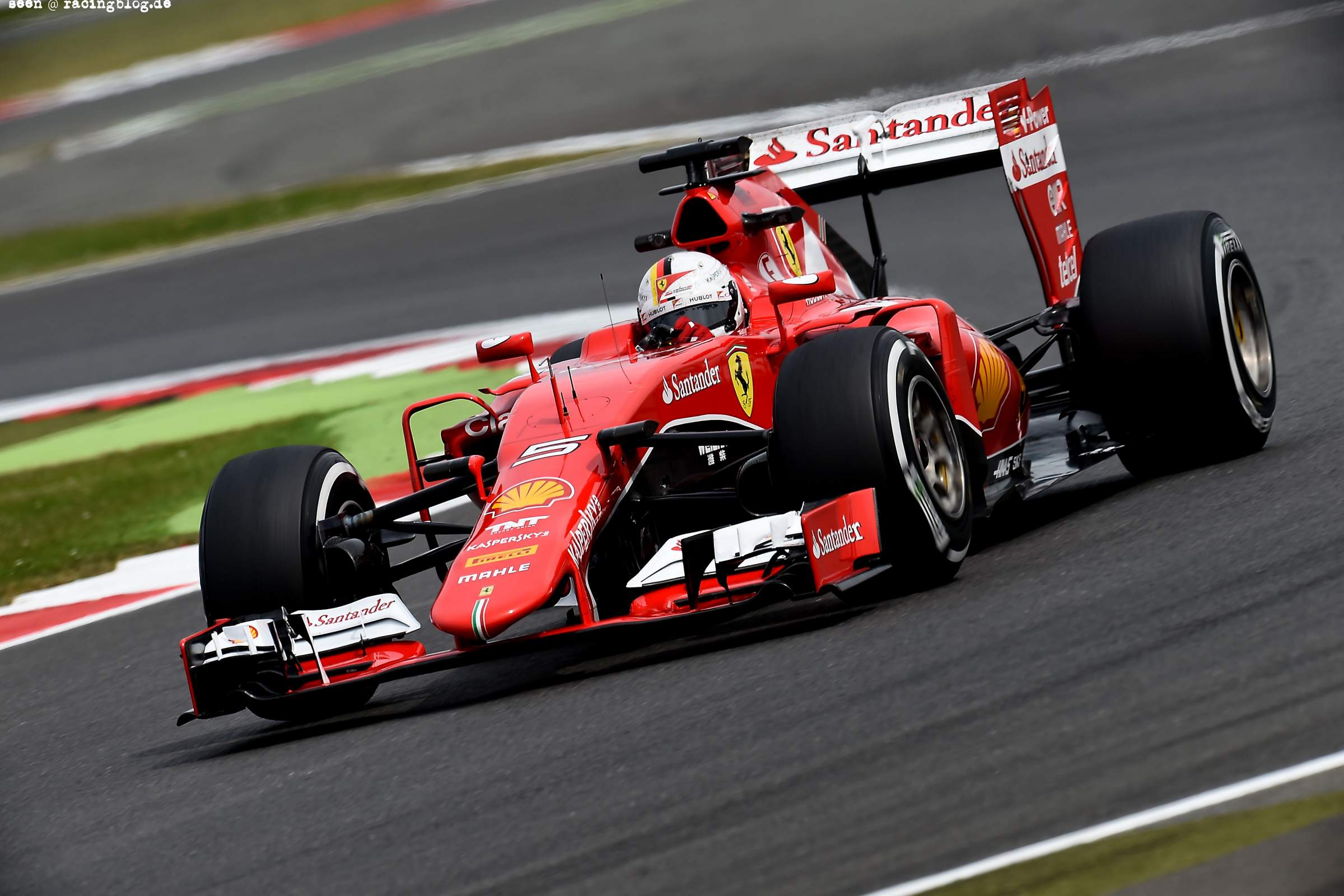The best race of the 2015 season so far, the Hungarian Grand Prix hinged on some big decisions and as a result there were some big gains and some expensive mistakes made. So what was going on behind the scenes in those crucial decisions?
As last year, a Safety Car proved to be a real turning point in the race, which helped some and really hindered others. Nico Rosberg lost the chance to take a huge bite out of Lewis Hamilton’s points lead, but paid a heavy price for a lack of aggression and ambition. Meanwhile the Red Bull drivers both reached the podium after disastrous starts to the race. Here we will analyse how it all happened and look at the controversial decision by Toro Rosso to give Max Verstappen strategy advantage even though he was behind his team mate on the road in the opening stint.
Could Rosberg have won the race with a different tyre choice at the final pit stop?
 The fans are all talking about this one; Nico Rosberg fitted a set of medium compound tyres at his second stop and as a result was unable to challenge Sebastian Vettel for the win and also fell into the clutches of Daniel Ricciardo, which led to a costly collision and a puncture for the German.
The fans are all talking about this one; Nico Rosberg fitted a set of medium compound tyres at his second stop and as a result was unable to challenge Sebastian Vettel for the win and also fell into the clutches of Daniel Ricciardo, which led to a costly collision and a puncture for the German.
So why didn’t he take a set of soft tyres at that final stop?
The background to this is that prior to the Safety Car deployment for the accident of Nico Hulkenberg, Rosberg had been asking his team to prepare a set of medium tyres for the final stint. Rosberg had already used medium tyres in the middle stint, in order to offset himself against the Ferraris of Vettel and Kimi Raikkonen, which had taken the lead at the start. There was no point in Rosberg fitting the same tyres as them at the first stop; better to go a different route and hope that a late race turnaround, like a Safety Car, will play into your hands.
However, having struggled to match the pace of the Ferraris throughout the race, as the second stops approached, Rosberg wasn’t thinking about beating them, he was thinking about containing his team mate Lewis Hamilton, who was coming through the field after a disastrous opening lap dropped him to 10th.
As the race entered its second half, Rosberg in third place, was told that Hamilton, lying fourth some seven seconds behind him, would be pitting before him to fit mediums. Rosberg replied that he would do the same and effectively ‘cover’ his team mate.
At this point he was 23 seconds behind the race leader Vettel and 15 behind Raikkonen.
This showed a rather disappointing lack of ambition on Rosberg’s part. Also it had echoes of the disastrous late tyre decision Hamilton made in Monaco, which was also aimed at covering off his team mate and trying to get the team to do something which was in his interest rather than the team’s.
It is not in Mercedes’ interests to have one car slowing the other one down, which is what Rosberg was seeking to do. Their interest is in winning the race. They were asking him to close up to Raikkonen, so that he could take advantage of the soft tyres in the final stint and attack.
For Mercedes, the race was still potentially winnable at this stage; as Hamilton was the fastest car on track when running in clean air and Rosberg had the chance to catch the Ferraris late in the race on soft tyres, when they were on mediums, on which they don’t always perform well. Around this time it also became clear that Raikkonen was losing power from his ERS, so Mercedes were on alert that a minimum second place was there for the taking. From here Mercedes should have finished in second and third places at a minimum. Discussion ensued and Mercedes prepared a set of medium tyres in the rack for Rosberg’s next stop.
 Then Hulkenberg crashed on Lap 42 and the Race Director activated the Virtual Safety Car, which means that drivers slow down but maintain the same race gaps. This gave the Race Director some thinking time, as to whether to deploy a full Safety Car.
Then Hulkenberg crashed on Lap 42 and the Race Director activated the Virtual Safety Car, which means that drivers slow down but maintain the same race gaps. This gave the Race Director some thinking time, as to whether to deploy a full Safety Car.
The Ferraris had already started a new lap; Rosberg was next to the pit entry and came in, followed seven seconds behind by Hamilton. The Mercedes team did not have time to change the set of tyres in Rosberg’s rack and so the mediums he had been planning to use were fitted to the car, despite an obvious opportunity being there for him to fit softs and then attack Vettel from the restart.
A smarter and more aggressive move would have been to do another lap, as Ferrari was doing and talk through the tactics with the pit wall, giving them the time they need to switch a set of softs into the rack. There were still 28 laps to go, which are too many for a set of soft tyres, but clearly the debris was extensive and therefore the Race Director was likely to deploy a Safety Car, which would take several laps to clear.
Had he been thinking aggressively in terms of trying to win, Rosberg would have played the decision-making in Hungary quite differently. It is an interesting case study, which he needs to reflect on; if he is going to try to win the World Championship, it will be by being bold on days like this when his team mate has scored an own goal and is making mistakes. Instead he tried to take the safe route and it ultimately cost him the chance to level the championship at the half way stage.
Red Bulls recover and ride their luck to the podium
 Red Bull got its first podium of 2015 with Daniil Kvyat in second and Daniel Ricciardo in third. Both drivers benefitted from the Safety Car and from the faster cars ahead of them hitting problems. If Mercedes had had a normal race and Raikkonen’s car had not retired, Kvyat would have been fifth.
Red Bull got its first podium of 2015 with Daniil Kvyat in second and Daniel Ricciardo in third. Both drivers benefitted from the Safety Car and from the faster cars ahead of them hitting problems. If Mercedes had had a normal race and Raikkonen’s car had not retired, Kvyat would have been fifth.
He flat spotted his tyres at the start and had poor pace in the opening stint so the team asked him to let Ricciardo through. But the Australian ended up behind him at the flag after some aggressive overtakes led to him damaging his car.
Kvyat had stopped very early on Lap 13 and so was on a three stop strategy, which would not have been competitive, but the Safety Car allowed him to close up and as he’d done the same as Rosberg and fitted mediums at the first stop, he was in great shape on a new set of soft tyres for the final stint.
Ricciardo was in aggressive mode from Saturday; he had saved a new set of soft tyres in qualifying to attack on Sunday and he did so in the final stint. After the Safety Car, he had a good chance to win the race thanks to this aggressive approach, which is what Rosberg could have done with showing.
Was Toro Rosso correct to favour Max Verstappen over Carlos Sainz
There was some controversy after the race when it emerged that Toro Rosso had let Max Verstappen undercut his team mate Carlos Sainz at the first pit stop, something you normally do to rivals, not your own team mate. Normally the leading car gets the priority at the first pit stop.
Red Bull ordered Kvyat to let Ricciardo through because he had damaged his tyres and was holding him up. That is fair enough.
Verstappen also felt he was being held up by Sainz, but the team had no reason to issue similar orders. However, exhibiting the kind of pragmatism that is possible in a ‘training camp’ type team structure such as Toro Rosso, they gave Verstappen the first pit stop.
When Sainz pitted he lost a further three seconds as he was held to avoid an unsafe release and so not only did he fall behind Verstappen, he also lost track position to Alonso.
This is tough to take for Sainz, who has had a very impressive start to his F1 career, but it was the right thing to do as analysis of the lap times shows that Verstappen was faster on the day and it led to Toro Rosso getting 12 points for his fourth place, points they badly needed and which will be worth literally millions to them at the end of the year.
The UBS Race Strategy Briefing is written by James Allen with input and data from several F1 team strategists and from Pirelli


